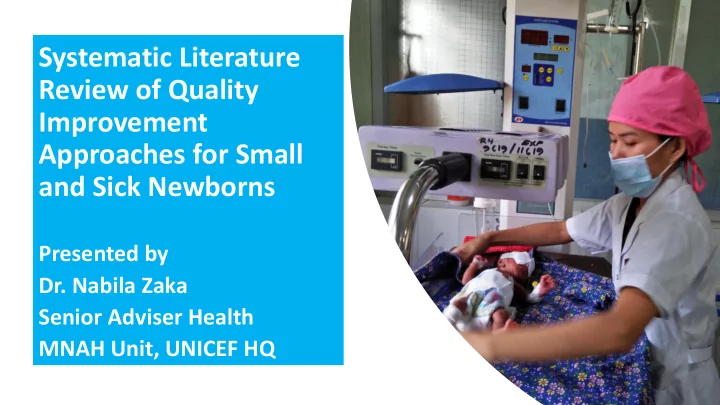

Systematic Literature Review of Quality Improvement Approaches for Small and Sick Newborns Presented by Dr. Nabila Zaka Senior Adviser Health MNAH Unit, UNICEF HQ
Findings from Systematic literature review
1 2 3 Study To identify and categorise To identify barriers and To identify and categorise Objectives outcomes investigated promoters, at a local level quality improvement byquality improvement and systems level, to the approaches for small/sick initiatives for small/sick implementation of quality hospitalised newborns in hospitalised newborns in improvement initiatives for LMICs LMICs small/sick hospitalized newborns in LMICs
Populations: in LMICs and admitted LMICs were identified hospitalised small for inpatient according to the World and/or sick newborns healthcare. Bank list l Facilities for this population must be Interventions: quality according to the defined as ‘hospitals’ improvement Ovretveit definition or units within initiatives, hospitals. “better patient Methods changing provider through using a experience and behaviour and systematic change outcomes achieved organisation method and strategies through Outcomes: objective mortality, morbidity, Language: studies clinical outcomes and process of care published in English, or relating to measures. with translation Year: published from 2000 or later.
Study Selection
Classification of QI approaches
Rama Swamy et al. used regulation and Yaw son et al. governance in their Utilized task shifting, development of the by using a tool to Ridge-Kybele Model Macrolevel identify service gaps for Obstetric and which led to national Neonatal care, an and regional Interventions integrated approach operating plans for systems change being developed and which prioritises implemented to (2) capacity building in improve neonatal order to properly care. embed change practices. No studies were found for particular methods including pay for performance, other financing incentives, pre-service training, and external to health system
Rosenthal et al. introduced a multi-faceted infection control bundle incorporating education on hand hygiene and asepsis Agarwal et al. developed a package of on-job training of 1. In-service training nurses on common neonatal skills. Meso level Interventions Clark et al. used WHO Emergency triage and treatment course (20) Rahman et al. used triage and fast assessment & use of a record system 2. Service organization Erdeve et al. Evaluated the impact of individual rooms on patients and families in the NICU Often delivered as a bundle of innovations Mortality audits and franchising models were not used
Distribution of Referencing materials to providers Micro-level Dissemination of a new protocol for low birth weight babies (8 studies) Implementation of new guidelines
Motivation of key Importance of local Promoters individuals champions Good quality data imp Structured community NGO collaboration, for QI relationships MoH support Promoters and Barriers Insufficient Over-burdened equipment(paper Barriers staff/competing supplies running low demands and no computerized patient records. Increasing demand for hospital services and Staff turn-over or re- lack of finances for distribution necessary medicine
Safe care: 13 Groups of outcomes Effective Care: 5 measured in Efficient care: 2 quality improvement People centred care :2 approaches Equitable care:0
The most frequently assessed outcomes were mortality rates, sepsis and infection rates. These studies demonstrate the potential for QI to produce swift and significant benefits for this vulnerable patient group. Key Learnings Majority of the included studies were non-randomized before - after studies, and a review by Schouten et al. found that observational (1) studies tend to demonstrate larger effects than more rigorous designs Studies with greater involvement of family members reported significant positive results for mortality, sepsis, and re-admission rates, suggesting this area could be explored further It will be important to focus future QI efforts on sepsis due to rising rates of antibiotic resistant infections and sepsis in this group
Several studies benefitted from focusing their efforts on single pathologies (ventilator-associated pneumonia, central line-associated blood stream infections) for quality improvement, which allowed for collation of findings across multiple centres In service trainings as QI approach and the need for control groups Key Learnings Barriers and facilitators can provide insights for programme improvements (2) QI approaches are heavily data dependent and programmes can benefit by investing in improving standard metrics and quality of data Mortality audits were not utilized by any of the included studies The bottlenecks of health financing, health workforce, data and community engagement need more varied approaches to implementation and research, especially at Macro level
The heterogeneity of our study population, the QI interventions and multiple outcome measures were key challenges. Community based interventions not included Publication bias as many QI approaches not published Limitations Did not capture qualitative elements as parent experiences Only papers from 2000 and in English language were included Limited equity analysis information available
Recommendations 1 2 3 4 Targeted resources will be QI implementation should More investments required Small and sick hospitalised needed to strengthen take place in tandem with in QI implementation newborns in LMICs are a human resource capabilities strong data collection and research in LMICs (research population at the highest for implementation research monitoring. in high income settings not risk, they should be one of into quality improvement applicable) the prime beneficiaries of for small and sick newborn quality of care interventions care and to document and investments. outcomes, costs, and lessons learnt.
Thank you
Recommend
More recommend